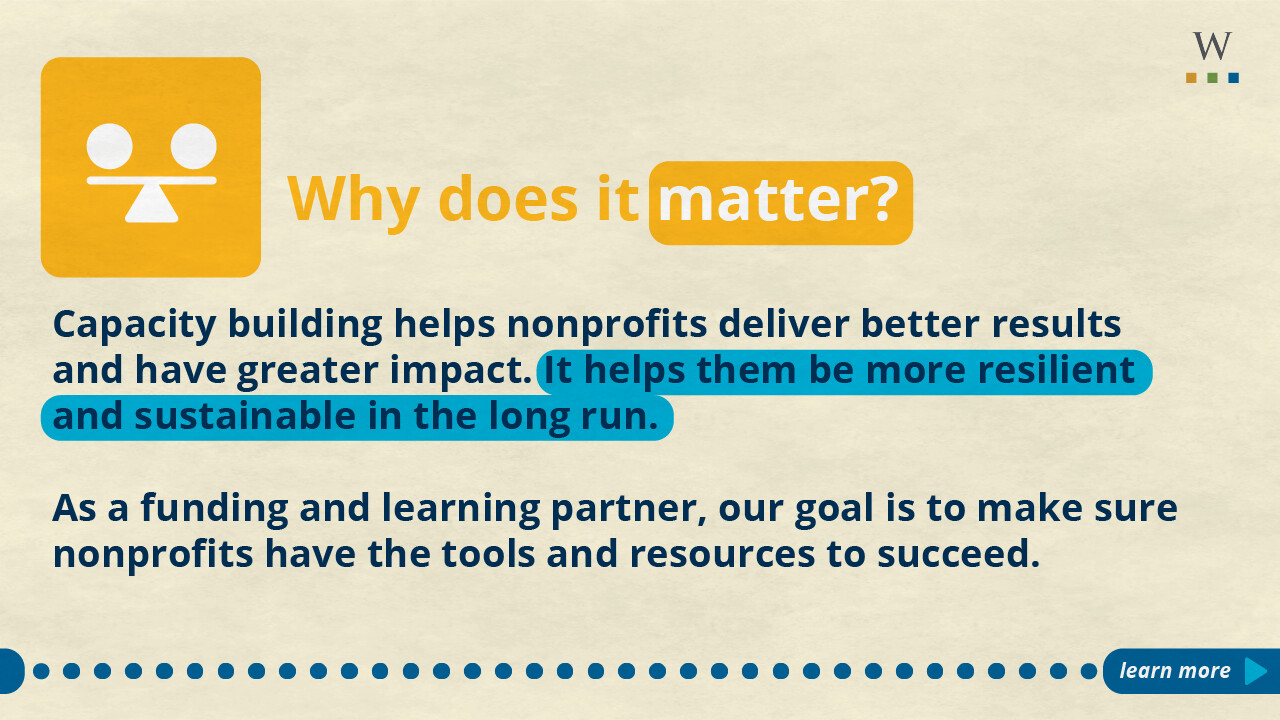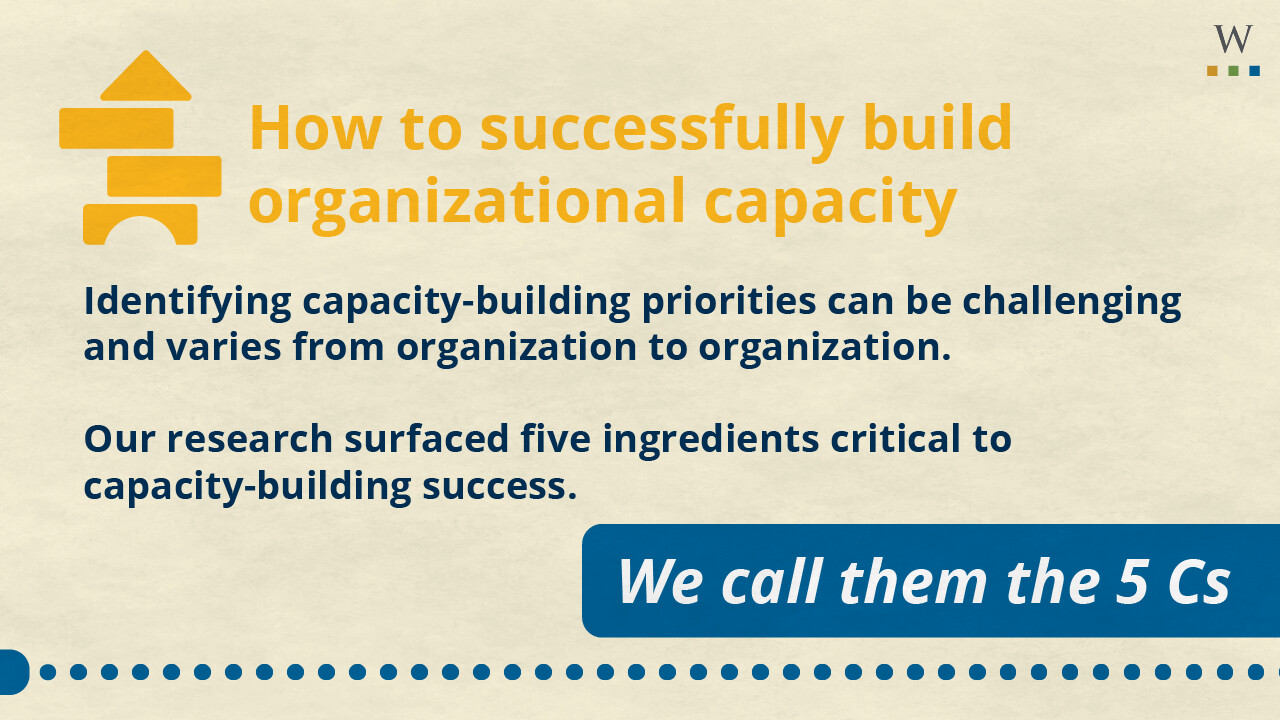Walton Family Foundation grantees all share one thing in common. They are people driven by extraordinary purpose. From educators and entrepreneurs to farmers and filmmakers, each demonstrates the courage and bold ideas to solve the challenges facing their communities.
Oftentimes though, moving from purpose to action can be one of the biggest challenges grantees have to overcome.
Some grantees may be well versed in creating and scaling organizations. But for others, knowing how to staff up, cultivate stable leadership, develop organizational infrastructure like accounting practices and other “back office” necessities, and achieve objectives on a timeline are areas of expertise that need to be learned and developed over time.
Capacity building, as it’s commonly referred to, is the process a grantee undergoes to develop these critical organizational capabilities. Capacity building helps grantees be more effective in their ability to deliver results. It helps them be more resilient in the face of adversity. And it helps them become more sustainable over the long term.
But while capacity building is a term used frequently in philanthropy, exact definitions and practices can vary widely.
Ensuring grantee partners have the tools and resources they need to run successful organizations is fundamental not only for the Walton Family Foundation’s own mission-driven goals, but for philanthropy as a whole.
The foundation wanted to better understand how we support grantees in their capacity-building efforts. We recently enlisted TCC Group to examine our current practices and recommend how we can expand and strengthen our approach.
It’s part of an ongoing effort by the foundation to better understand, measure and improve our current practices by listening directly to our partners in the field. As this learning journey continues, it’s also important to share the knowledge we gather.
The project surfaced several key learnings about our capacity-building practices:
1. While all foundation program areas engage in grantee capacity building, approaches to this support vary widely.
The capacity-building goals most commonly cited by foundation staff were “building financial sustainability” and helping organizations go from “good to great.” These are admirable end goals. But program officers need a consistent and strategic approach to meaningfully achieve them. To get there, TCC created a roadmap. It outlined a set of common short-term, intermediate-, and long-term capacity-building outcomes. Creating a consistent, detailed pathway to success lays the groundwork for better, more realistic expectations.
2. Grantees and foundation staff can both contribute unique and valuable perspectives about capacity-building priorities. These are rooted in a trusting relationship and spirit of collaboration.
The process of identifying capacity-building priorities can be challenging. Existing models and frameworks about grantee capacity mostly focus on an organization’s maturity. Or their capacity gaps. These can be helpful to know. But they do not necessarily identify fruitful areas for targeted capacity-building support efforts. In our project, grantee and staff perspectives on the components of strong grantee organizations and readiness for “good to great” capacity building were highly aligned. This suggests a shared starting place for identifying capacity-building priorities.
3. Capacity building is more successful when it follows the 5 Cs.
Foundation staff and grantees collectively identified five elements critical to capacity-building success. They include priorities that are:
Contextual. They address the unique positioning of each grantee within its field.
Current. They address an immediate need.
Concrete. They result in tangible deliverables.
Customized. They are tailored to meet the grantee’s specific needs.
Continuous. They represent a sustained effort to develop a grantee's skills, knowledge and resources over time.
The report also surfaced a number of challenges that make capacity building less likely to be successful. They include:
- Solely emphasizing technical skills while overlooking essential underlying infrastructure requirements. One example is providing training on financial controls without ensuring the grantee has an up-to-date accounting platform.
- Not accounting for the possibility of future staff transitions.
- Lack of alignment between grantees and providers tapped to help them build capacity.
- Attempting to take on too much all at once, especially for smaller organizations.
4. Grantees and partners value deliberate and direct conversations on capacity building.
The report revealed that grantees believe the foundation is a collaborative partner on capacity-building. But it also reminded us that the foundation needs to be direct with grantees about what we are talking about. TCC reported that after one seemingly enthusiastic meeting, a grantee went home that night and googled, “What is capacity building?”
It is important to recognize that the technical jargon can get in the way of this work. When we use imprecise or jargony language, it can obscure the goal. Consistent and clear communication makes it easier for grantees and program officers to discuss and set capacity-building priorities.
5. Grantees appreciate dedicated funding for capacity-building efforts.
Grantee operations are frequently laser focused on their primary social and environmental missions. Capacity building is a worthy pursuit. But actually designating funding for that purpose is another matter entirely. The report found that dedicated capacity-building support for grantees helped them to explicitly consider ways to strengthen their capabilities in ways programmatic or general support funding could not. One grantee put it this way: “Dedicated funding freed us to devote time, human power and energy to the capacity-building tasks at hand as opposed to the myriad other needs that compete for our attention.” Even when capacity-building assistance is provided by a third party, grantees still appreciate funder engagement. Moving forward, we’ll be listening closely to grantees on the grant structure and the foundation’s role in providing support that works best for them.
As to the foundation learns more about how to best support grantees and achieve program goals, we look forward to sharing these learnings with our partners in the field.
Read the full capacity-building report here.










